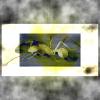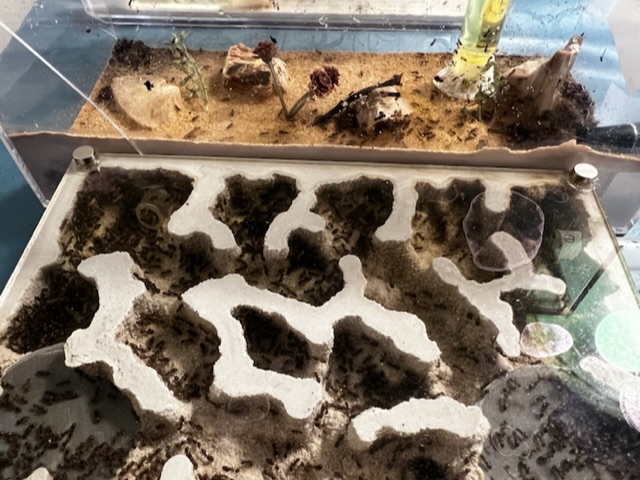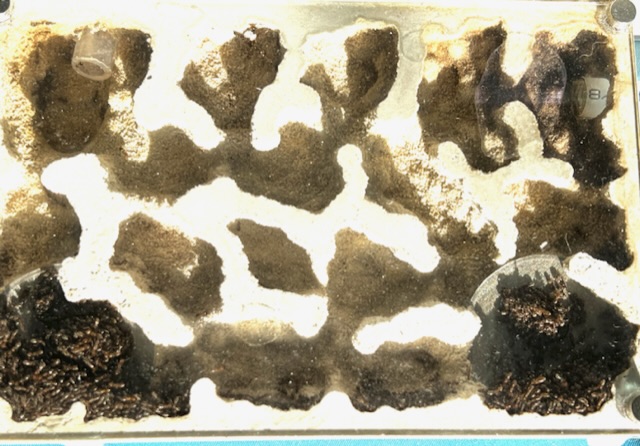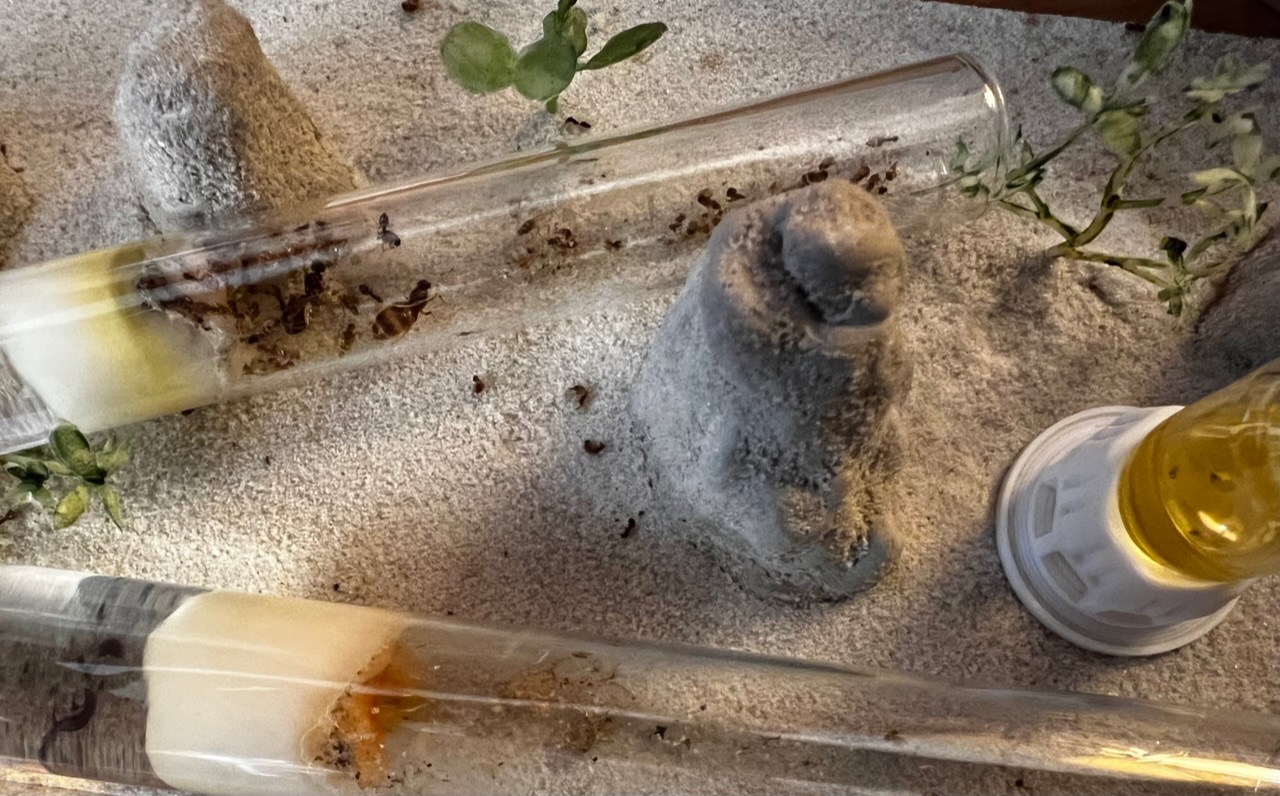oo, ahh
Edited by ArcaneAnt, July 11 2022 - 1:20 PM.

oo, ahh
Edited by ArcaneAnt, July 11 2022 - 1:20 PM.
Welllll lost my Myrmecocystus …. I will say the pots seemed EXTREMELY sensitive to what might be trace chemicals or something else in their environment.
Prenos - I still have a few from 2022. I was planning to do an experiment where I added new queens to existing colonies. However, this year (2023) they flew in March thanks to extreme California rainy weather, rather than the January or February of the last few years, and I pretty much missed the flights (though I knew they were happening because I saw a couple lost males). I caught one queen that sadly died within a couple days.
Lios are still okay so far (pic below).
Edited by OhNoNotAgain, March 22 2023 - 5:27 PM.
Past & Present
Veromessor pergandei, andrei, stoddardi; Novomessor cockerelli
Camponotus fragilis, Camponotus sansabeanus (inactive), vicinus, laevigatus/quercicola, CA02
Pogonomyrmex subnitidus, P. californicus (inactive)
Liometopum occidentale (inactive); Prenolepis imparis; Myrmecocystus mexicanus (inactive); Tetramorium sp. (inactive); Lasius sp.
Termites: Zootermopsis angusticollis, and a box of drywood termites that can't be seen
Isopods: (most no longer keeping) A. gestroi, granulatum, kluugi, maculatum, vulgare; C. murina; P. hoffmannseggi, P. haasi, P. ornatus; V. parvus, P. pruinosus, T. tomentosa
Spoods: (no longer keeping) Phidippus sp., other
Lios were all bunched up in just 2-3 chambers most of the winter, but today I fed them (cooked bugs I froze months ago, plus a refill of their sugar water), put water into their water towers, refilled their water nestmate, and now they are very excited and have spread out to occupy all available space. Sort of like ant diffusion.

Edited by OhNoNotAgain, March 22 2023 - 5:30 PM.
Past & Present
Veromessor pergandei, andrei, stoddardi; Novomessor cockerelli
Camponotus fragilis, Camponotus sansabeanus (inactive), vicinus, laevigatus/quercicola, CA02
Pogonomyrmex subnitidus, P. californicus (inactive)
Liometopum occidentale (inactive); Prenolepis imparis; Myrmecocystus mexicanus (inactive); Tetramorium sp. (inactive); Lasius sp.
Termites: Zootermopsis angusticollis, and a box of drywood termites that can't be seen
Isopods: (most no longer keeping) A. gestroi, granulatum, kluugi, maculatum, vulgare; C. murina; P. hoffmannseggi, P. haasi, P. ornatus; V. parvus, P. pruinosus, T. tomentosa
Spoods: (no longer keeping) Phidippus sp., other

Past & Present
Veromessor pergandei, andrei, stoddardi; Novomessor cockerelli
Camponotus fragilis, Camponotus sansabeanus (inactive), vicinus, laevigatus/quercicola, CA02
Pogonomyrmex subnitidus, P. californicus (inactive)
Liometopum occidentale (inactive); Prenolepis imparis; Myrmecocystus mexicanus (inactive); Tetramorium sp. (inactive); Lasius sp.
Termites: Zootermopsis angusticollis, and a box of drywood termites that can't be seen
Isopods: (most no longer keeping) A. gestroi, granulatum, kluugi, maculatum, vulgare; C. murina; P. hoffmannseggi, P. haasi, P. ornatus; V. parvus, P. pruinosus, T. tomentosa
Spoods: (no longer keeping) Phidippus sp., other

Edited by OhNoNotAgain, April 3 2023 - 1:03 PM.
Past & Present
Veromessor pergandei, andrei, stoddardi; Novomessor cockerelli
Camponotus fragilis, Camponotus sansabeanus (inactive), vicinus, laevigatus/quercicola, CA02
Pogonomyrmex subnitidus, P. californicus (inactive)
Liometopum occidentale (inactive); Prenolepis imparis; Myrmecocystus mexicanus (inactive); Tetramorium sp. (inactive); Lasius sp.
Termites: Zootermopsis angusticollis, and a box of drywood termites that can't be seen
Isopods: (most no longer keeping) A. gestroi, granulatum, kluugi, maculatum, vulgare; C. murina; P. hoffmannseggi, P. haasi, P. ornatus; V. parvus, P. pruinosus, T. tomentosa
Spoods: (no longer keeping) Phidippus sp., other
I have a whole bunch of Prenolepis videos at this point, on catching them, and now a check of my oldest Preno colony (entering its 3rd year).
Also, Liometopum made a quick cameo in my ant size video. I'll post a bunch of links to the Preno (and semi-Lio) videos:
Catching Prenolepis (2 years ago, 2022)
Catching Prenolepis (2024)
AFTER a Preno flight it's sad (2024)
Checking on Prenolepis after 2 years and after 2 months.
Includes some simple care instructions for Prenolepis.
Ant sizes matter, featuring Liometopum occidentale as well as Camponotus laevigatus
Edited by OhNoNotAgain, March 28 2024 - 7:20 PM.
Past & Present
Veromessor pergandei, andrei, stoddardi; Novomessor cockerelli
Camponotus fragilis, Camponotus sansabeanus (inactive), vicinus, laevigatus/quercicola, CA02
Pogonomyrmex subnitidus, P. californicus (inactive)
Liometopum occidentale (inactive); Prenolepis imparis; Myrmecocystus mexicanus (inactive); Tetramorium sp. (inactive); Lasius sp.
Termites: Zootermopsis angusticollis, and a box of drywood termites that can't be seen
Isopods: (most no longer keeping) A. gestroi, granulatum, kluugi, maculatum, vulgare; C. murina; P. hoffmannseggi, P. haasi, P. ornatus; V. parvus, P. pruinosus, T. tomentosa
Spoods: (no longer keeping) Phidippus sp., other
So update:
Lio:
Still going. It's August and they are nursing a huge brood pile.
Preno:
I have grouped up the Prenolepis to save space, dividing the surviving starting queens as follows:
Bin 1: The 2 year old (3rd year?) colony is sharing its bin with a starter tube. (Said 3rd year colony also ran out of water in its tube, but refuses to move out....)
Bin 2: The other two starter tubes are sharing another bin, both open. The colonies are free to interact or merge.
As for the long-dead Myrmecocystus, I mayyyy try again this year.
Past & Present
Veromessor pergandei, andrei, stoddardi; Novomessor cockerelli
Camponotus fragilis, Camponotus sansabeanus (inactive), vicinus, laevigatus/quercicola, CA02
Pogonomyrmex subnitidus, P. californicus (inactive)
Liometopum occidentale (inactive); Prenolepis imparis; Myrmecocystus mexicanus (inactive); Tetramorium sp. (inactive); Lasius sp.
Termites: Zootermopsis angusticollis, and a box of drywood termites that can't be seen
Isopods: (most no longer keeping) A. gestroi, granulatum, kluugi, maculatum, vulgare; C. murina; P. hoffmannseggi, P. haasi, P. ornatus; V. parvus, P. pruinosus, T. tomentosa
Spoods: (no longer keeping) Phidippus sp., other
I made a video about Liometopum occidentale as pets:
Past & Present
Veromessor pergandei, andrei, stoddardi; Novomessor cockerelli
Camponotus fragilis, Camponotus sansabeanus (inactive), vicinus, laevigatus/quercicola, CA02
Pogonomyrmex subnitidus, P. californicus (inactive)
Liometopum occidentale (inactive); Prenolepis imparis; Myrmecocystus mexicanus (inactive); Tetramorium sp. (inactive); Lasius sp.
Termites: Zootermopsis angusticollis, and a box of drywood termites that can't be seen
Isopods: (most no longer keeping) A. gestroi, granulatum, kluugi, maculatum, vulgare; C. murina; P. hoffmannseggi, P. haasi, P. ornatus; V. parvus, P. pruinosus, T. tomentosa
Spoods: (no longer keeping) Phidippus sp., other
Just made an instructional video about combining Prenolepis imparis colonies (if in test tubes). Includes footage of a 3rd year Prenolepis colony that merged with a 1st year Prenolepis starter colony.
Edited by OhNoNotAgain, August 16 2024 - 10:24 PM.
Past & Present
Veromessor pergandei, andrei, stoddardi; Novomessor cockerelli
Camponotus fragilis, Camponotus sansabeanus (inactive), vicinus, laevigatus/quercicola, CA02
Pogonomyrmex subnitidus, P. californicus (inactive)
Liometopum occidentale (inactive); Prenolepis imparis; Myrmecocystus mexicanus (inactive); Tetramorium sp. (inactive); Lasius sp.
Termites: Zootermopsis angusticollis, and a box of drywood termites that can't be seen
Isopods: (most no longer keeping) A. gestroi, granulatum, kluugi, maculatum, vulgare; C. murina; P. hoffmannseggi, P. haasi, P. ornatus; V. parvus, P. pruinosus, T. tomentosa
Spoods: (no longer keeping) Phidippus sp., other
Sooooo as mentioned in another journal, this year was somehow absolutely meh. I blame health problems. I lost a few colonies this year I was not expecting to lose.
However, I think I know what killed by lovely but scary Liometopum.
While I was out of town and not due back for weeks, the Liometopum - healthy colony, plenty of tiny little aggressive workers - staged a formicarium escape. Liometopum are small, maybe tiny, and they had made it through a gap on the side of the nest mate water tube.
Keep in mind, I was thousands of miles away. Over the phone, I was running out of ideas and finally suggested wrapping mineral oil-soaked cotton around the base of the tube.
Now, this worked. It stopped the Lios from escaping and running all over the dining room table and trying to visit all the other ants (we all know what a good idea that is not). HOWEVER, what I did not realize is that the oil would then creep into the formicarium.
When I got back home I was very busy, also tired/exhausted, feeling meh, and not paying attention very well. What I describe with the creeping oil is what I believe eventually killed the queen.
What a feisty colony it was. Those little tiny ants were fierce. Ate everything protein down to dust, unlike all the picky Camponotus, Prenos, and so on that leave everything as trash. I miss them. I don't miss their escape antics, but you can't ask for an easier to keep small/tiny species than Liometopum. (And yes, they are SLIGHTLY bigger than Tetramorium, iirc.)
PRENOLEPIS:
I have two "colonies" still:
Colony 1 is the merged colony that had been in year 3 with an established queen. I merged in young queens from the same region. I believe they are down to 1 queen again. (very hard to see into the dirty blob of test tube). I have NO idea which queen it is. But, technically speaking, this Preno colony has been around for some years now (4+). They simply may now have a different queen. They have a relatively large number of workers, despite how poorly I fed them this year.
Colony 2 is a merged colony from the other area from which I regularly collect queens. (I wrote about them in previous entries.) They are still alive, with 2 queens. Their test tube is also filthy so it's hard to see....
LASIUS:
Let me mention I have one Lasius sp - no one knows exactly what species. Heck, I suck at ID'ing ants so I'm like, this is Lasius? Doesn't look my Lasius from the Midwest, but okay, sure. Lasius it is.
2024 Lasius are doing okay. They are hanging out in a test tube and the queen was alive when I checked half an hour ago.
Edited by OhNoNotAgain, November 17 2025 - 12:02 AM.
Past & Present
Veromessor pergandei, andrei, stoddardi; Novomessor cockerelli
Camponotus fragilis, Camponotus sansabeanus (inactive), vicinus, laevigatus/quercicola, CA02
Pogonomyrmex subnitidus, P. californicus (inactive)
Liometopum occidentale (inactive); Prenolepis imparis; Myrmecocystus mexicanus (inactive); Tetramorium sp. (inactive); Lasius sp.
Termites: Zootermopsis angusticollis, and a box of drywood termites that can't be seen
Isopods: (most no longer keeping) A. gestroi, granulatum, kluugi, maculatum, vulgare; C. murina; P. hoffmannseggi, P. haasi, P. ornatus; V. parvus, P. pruinosus, T. tomentosa
Spoods: (no longer keeping) Phidippus sp., other
Any photos/videos of the Lasius?
Ant Keeping & Ethology Discord - 2000+ Members and growing
Statesideants.com - order live ants legally in the US
0 members, 1 guests, 0 anonymous users